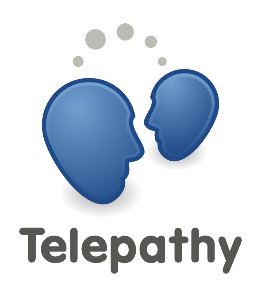Telepathy: Difference between revisions
(The bare beginnings of a Telepathy wiki page.) |
(Add interesting content) |
||
| Line 1: | Line 1: | ||
[[Image:Telepathy.png|right]] |
|||
Documentation of the Telepathy collaboration protocols can be found at http://telepathy.freedesktop.org/. |
|||
=Overview= |
|||
Telepathy is a framework for real-time conversations, including instant messaging, IRC, voice calls and video calls. It provides a modular approach to implementing these types of communications, so that applications do not have to reimplement common functionality. |
|||
Telepathy uses the D-Bus IPC system between components, allowing development of new components in any language, to conform to the Telepathy D-Bus specification. This means that Telepathy components can be added to existing applications which can talk D-Bus, without a hard dependency. |
|||
Telepathy is supported by [http://www.collabora.co.uk/ Collabora Ltd] |
|||
=Connection Managers= |
|||
Telepathy Connection Managers (CMs) provide the back ends for protocols. Since these are modular, a Telepathy-enabled application can use whichever CMs are available, providing they support the appropriate interfaces. |
|||
==Used by OLPC== |
|||
OLPC uses the following CMs: |
|||
* [[Gabble|Telepathy-gabble]]: for XMPP via a Jabber Server |
|||
* [[Salut|Telepathy-salut]]: for link local XMPP |
|||
See [[Shared Sugar Activities]] for an overview of activity collaboration, and [[Presence Service]] to see how the Sugar stack interfaces with these Telepathy CMs. |
|||
See [[Activity Sharing]] for some historical discussion on the rationale of using Telepathy for OLPC. |
|||
==Other CMs== |
|||
In addition, there are CMs implemented for the following protocols: |
|||
* Idle: IRC |
|||
* Telepathy-SofiaSIP: SIP |
|||
* Butterfly: MSN |
|||
* Haze: uses libpurple to provide all the protocols that Pidgin supports (AIM, ICQ, Yahoo, MSN...) |
|||
=More Telepathy Documentation= |
|||
The [http://telepathy.freedesktop.org/ Telepathy wiki] has documentation. In particular, see the following documents: |
|||
==Telepathy Spec== |
|||
At the core of Telepathy is the DBus interface specification which describes how Telepathy components communicate with each other. See [http://telepathy.freedesktop.org/spec.html Telepathy D-Bus Interface Specification] for the current version. |
|||
==Telepathy Architecture== |
|||
See [http://telepathy.freedesktop.org/wiki/System_Overview Telepathy Framework Architecture]. |
|||
This page will have descriptions of how Telepathy integrates with Sugar particularly. |
|||
[[Category:Software]] |
[[Category:Software]] |
||
[[Category:Telepathy]] |
|||
[[Category:Collaboration]] |
|||
Revision as of 18:20, 2 February 2008
Overview
Telepathy is a framework for real-time conversations, including instant messaging, IRC, voice calls and video calls. It provides a modular approach to implementing these types of communications, so that applications do not have to reimplement common functionality.
Telepathy uses the D-Bus IPC system between components, allowing development of new components in any language, to conform to the Telepathy D-Bus specification. This means that Telepathy components can be added to existing applications which can talk D-Bus, without a hard dependency.
Telepathy is supported by Collabora Ltd
Connection Managers
Telepathy Connection Managers (CMs) provide the back ends for protocols. Since these are modular, a Telepathy-enabled application can use whichever CMs are available, providing they support the appropriate interfaces.
Used by OLPC
OLPC uses the following CMs:
- Telepathy-gabble: for XMPP via a Jabber Server
- Telepathy-salut: for link local XMPP
See Shared Sugar Activities for an overview of activity collaboration, and Presence Service to see how the Sugar stack interfaces with these Telepathy CMs.
See Activity Sharing for some historical discussion on the rationale of using Telepathy for OLPC.
Other CMs
In addition, there are CMs implemented for the following protocols:
- Idle: IRC
- Telepathy-SofiaSIP: SIP
- Butterfly: MSN
- Haze: uses libpurple to provide all the protocols that Pidgin supports (AIM, ICQ, Yahoo, MSN...)
More Telepathy Documentation
The Telepathy wiki has documentation. In particular, see the following documents:
Telepathy Spec
At the core of Telepathy is the DBus interface specification which describes how Telepathy components communicate with each other. See Telepathy D-Bus Interface Specification for the current version.
